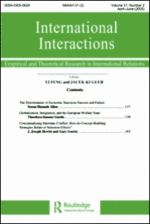The concept of relative power is ubiquitous and long-held in understanding conflict. As a ratio of the weaker side’s capabilities compared to the stronger side’s capabilities, relative power ranges from extreme asymmetry (where the weaker side has almost no capabilities) to parity (where the capabilities of the two sides are equal). Power theories link relative power to international outcomes, especially armed conflict. In this essay, we examine the applicability of power theories to civil armed conflicts, involving a government and a rebel group.
Butler, Christopher K. & Scott Gates (2009) Asymmetry, Parity, and (Civil) War: Can International Theories of Power Help Us Understand Civil War?, International Interactions 35 (3): 330–340.







